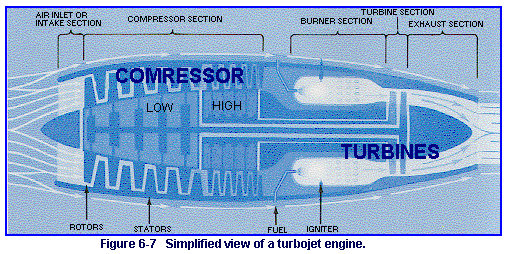 |
|||||
| Home | Research | For Teachers | HISTORY Level 1 Level 2 Level 3 |
PRINCIPLES Level 1 Level 2 Level 3 |
CAREER Level 1 Level 2 Level 3 |
| Gallery | Hot Links | What's New! | |||
| Web Administration and Tools | |||||
 |
|||||
| Home | Research | For Teachers | HISTORY Level 1 Level 2 Level 3 |
PRINCIPLES Level 1 Level 2 Level 3 |
CAREER Level 1 Level 2 Level 3 |
| Gallery | Hot Links | What's New! | |||
| Web Administration and Tools | |||||
![]()
The turbojet uses a series of fan-like compressor blades to bring air into the engine and compress it. An entire section of the turbojet engine performs this function, which can be compared to the compression stroke of the reciprocating engine. In this section, there is a series of rotor and stator blades. Rotor blades perform somewhat like propellers in that they gather and push air backward into the engine. The stator blades serve to straighten the flow of this air as it passes from one set of rotor blades to the next (see figure 6-7 ).

As the air continues to be forced further into the engine, it travels from the low-compression set of rotors and stators to the high-compression set. This last set puts what we might say is the final squeeze on the air.
The combustion chamber receives the high-pressure air, mixes fuel with it, and burns the mixture. The hot, very high-velocity gases produced strike the blades of the turbine and cause it to spin rapidly. The turbine is mounted on a shaft which is connected to the compressor. Thus, the spinning is what causes the compressor sections to function. After passing the turbine blades, the hot, highly accelerated gases go into the engine's exhaust section.
The exhaust section of the jet engine is designed to give additional acceleration to the gases and thereby increase thrust. The exhaust section also serves to straighten the flow of the gases as they come from the turbine. Basically, the exhaust section is a cone mounted in the exhaust duct. This duct is also referred to as the tailpipe. The shape of the tailpipe varies, depending on the design operating temperatures and the speed-performance range of the engine.
With all the heat produced in the turbojet engine, you probably wonder how it is kept from overheating. Like most aircraft reciprocating engines, the jet is also air-cooled. Of all the air coming into the compressor section, only about 25 percent is used to produce thrust; the remaining 75 percent passes around the combustion chamber and turbine area to serve as a coolant.
Send all comments to ![]() aeromaster@eng.fiu.edu
aeromaster@eng.fiu.edu
© 1995-98 ALLSTAR Network. All rights reserved worldwide.
| Funded in part by | From Civil Air Patrol Educational Materials |
Updated: February 23, 1999